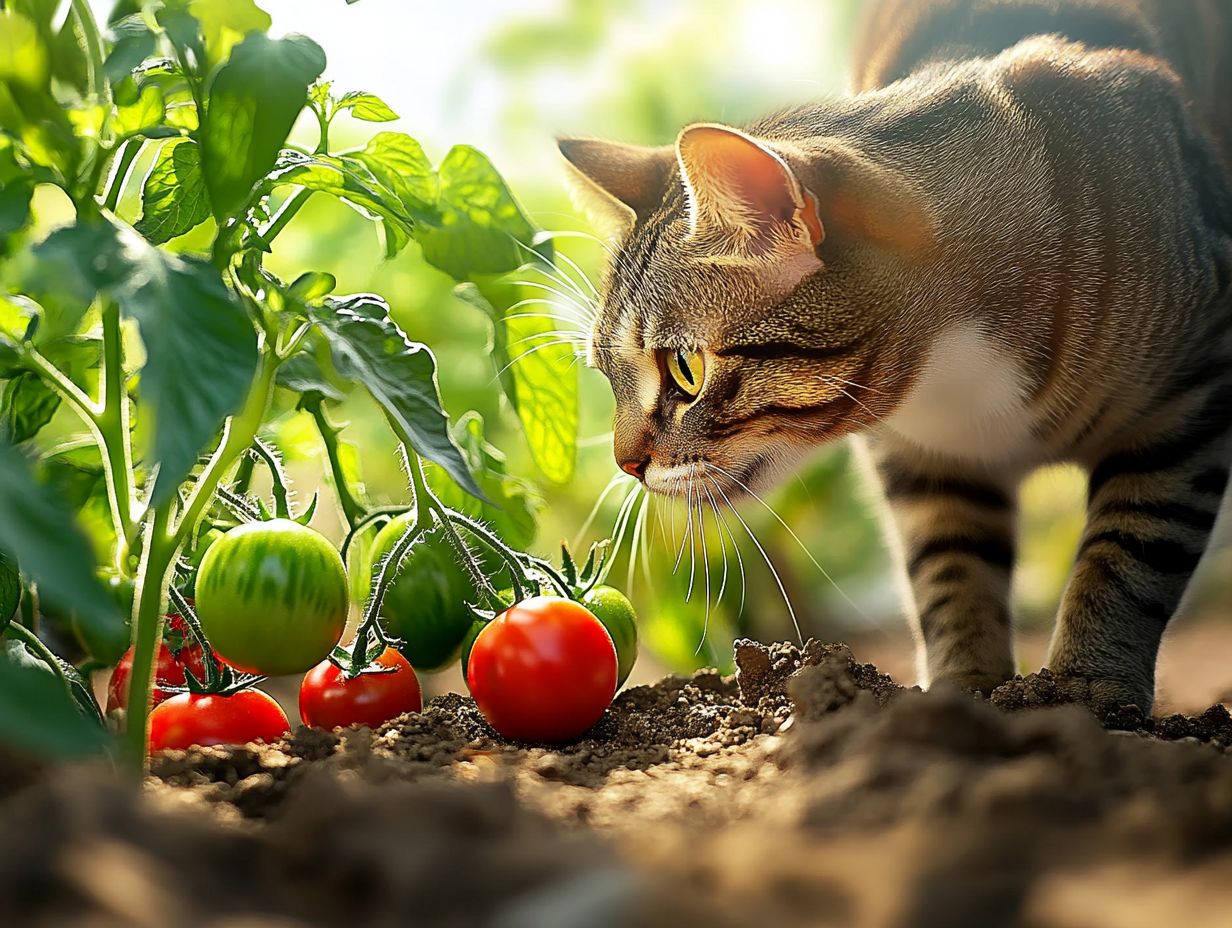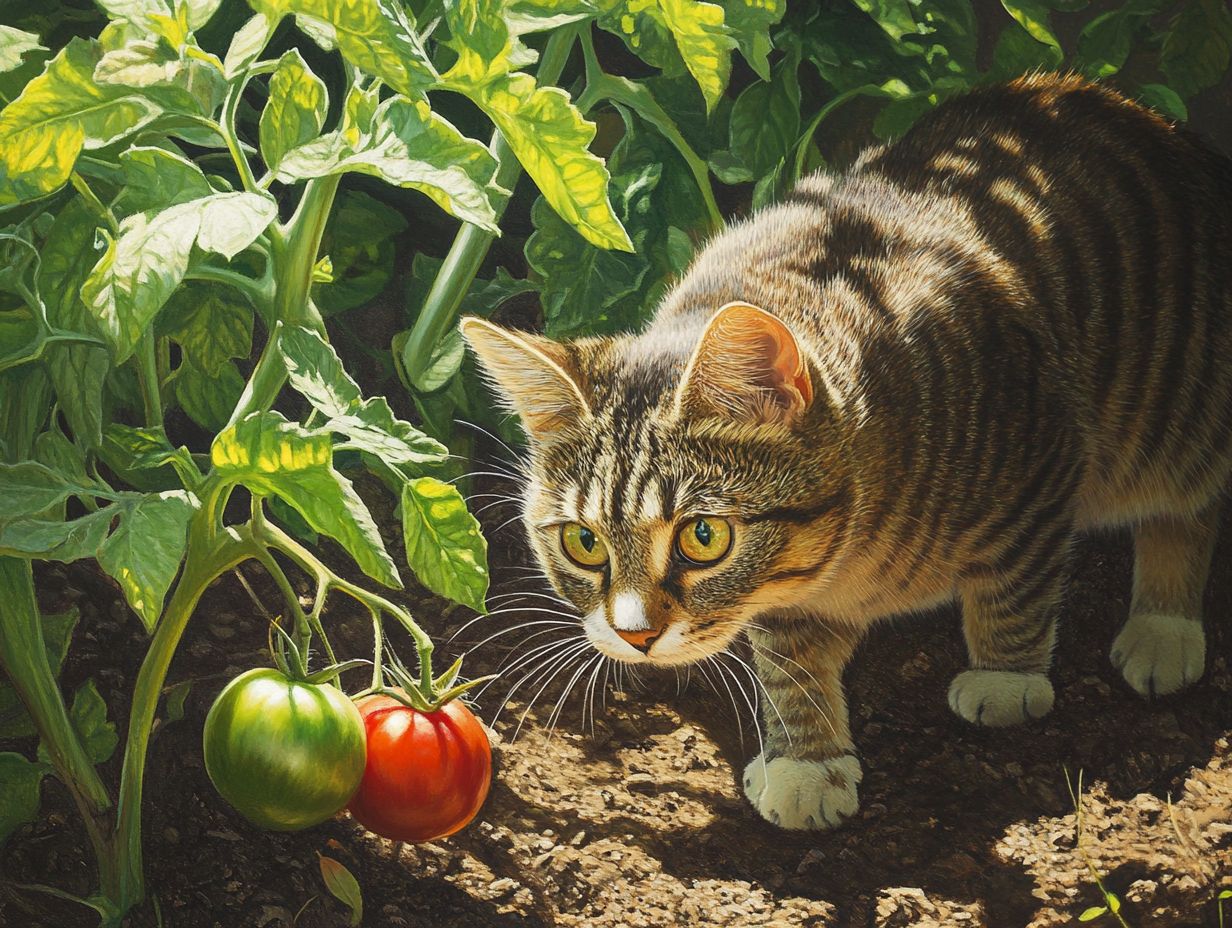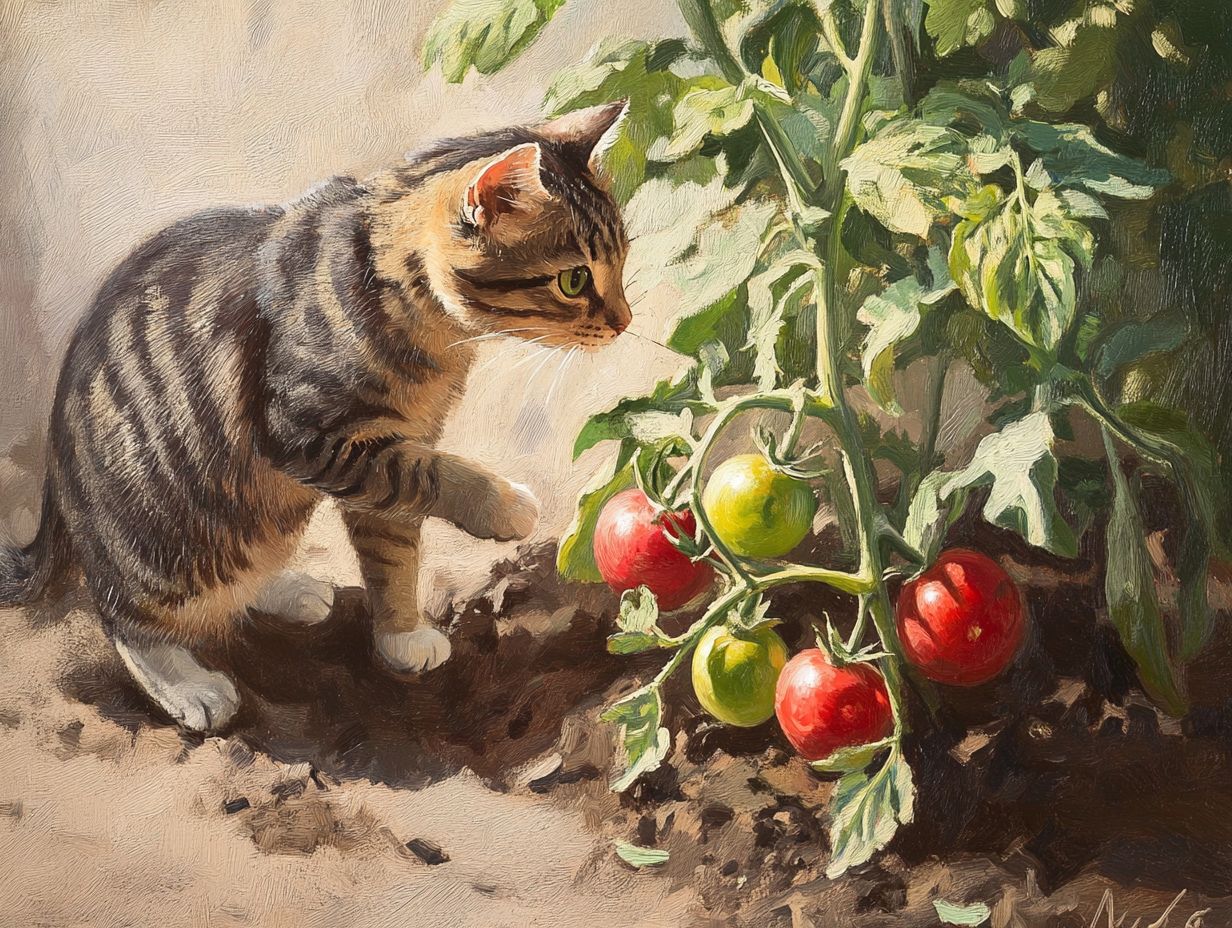Curious about whether your feline friend can safely roam around your tomatoes and tomato plants?
As a pet parent, it’s essential to know which common garden plants pose a risk to your cat’s health, such as the Nightshade family.
This article explores the dangers of tomato plants, including which parts are toxic and what symptoms to watch for if your cat accidentally indulges, such as gastrointestinal upset, vomiting, and lethargy.
Find tips on preventing curious kitties from munching on these plants and suggestions for safe alternatives that provide essential nutrients like potassium and vitamin C.
Read on to keep your cat safe and healthy with research-backed tips and advice from veterinarians!
Key Takeaways:

- Tomato plants, including cherry tomatoes and tomato paste, are classified as highly toxic to cats. It is important to prevent your cat from eating them.
- The leaves, stems, and unripe tomatoes contain solanine, which can cause gastrointestinal discomfort and other symptoms in cats.
- Ripe tomatoes are considered mildly toxic, but monitoring is still essential.
- If your cat ingests any part of a tomato plant, monitor them for symptoms such as:
- Mild Symptoms: Drooling
- Moderate Symptoms: Vomiting, diarrhea
- Severe Symptoms: Difficulty breathing, seizures, coma
- Seek veterinary care if necessary.
Can Cats Eat Tomato Plants?
The question of whether cats can eat tomato plants is a significant concern for pet owners who prioritize their cats’ health and safety. While tomatoes are a common household food, certain parts of the tomato plant can pose potential risks, as some components may be toxic to curious cats due to the presence of solanine and other alkaloids.
It is essential to carefully examine the relationship between cats and tomato plants, particularly if you are considering introducing these plants into your home or yard.
What Parts of the Tomato Plant Are Toxic to Cats?
Certain parts of the tomato plant are toxic to cats due to the presence of solanine and other alkaloids like alpha-tomatine and alpha-dehydrotomatine. Understanding which parts of the tomato plant are hazardous can help pet owners protect their curious felines from potential poisoning and gastrointestinal distress.
Are Tomato Leaves Toxic to Cats?
Tomato leaves are toxic to cats and can cause gastrointestinal upset if ingested in large amounts. Pet owners should be aware that the contents of tomato leaves and stems can harm their cats when tomato plants are present in the home, especially due to compounds like solanine.
While the ripe fruit is only mildly toxic, the foliage and green parts of the plant pose a greater risk. Symptoms of poisoning may include drooling, vomiting, diarrhea, and lethargy, which can progress to seizures and coma if left untreated. The presence of solanine and other alkaloids plays a significant role in these symptoms.
In case of suspected poisoning, pet owners should:
- Remove access to the plant.
- Contact your veterinarian or the ASPCA Animal Poison Control hotline at (888) 426-4435.
It is essential to create a safe garden and educate others about the potential dangers of certain plants for the well-being of our furry friends.
Are Green Tomatoes Toxic to Cats?
Green tomatoes, which are unripe, contain higher levels of solanine compared to their ripe counterparts, making them toxic to cats. Understanding the differences in tomato ripeness is crucial for pet owners who want to keep their feline friends safe and healthy.
Solanine is a naturally occurring chemical that is particularly concentrated in the leaves, stems, and unripe fruit of the tomato plant. In contrast, ripe tomatoes contain negligible amounts of this toxin, which means that green tomatoes pose a risk to pets.
To mitigate potential health risks, ensure that your feline does not have access to unripe tomatoes. Additionally, consider providing healthier alternatives such as commercial cat food that meets your cat’s dietary needs.
Are Tomato Stems Toxic to Cats?

Tomato stems are also toxic to cats. It is essential to educate yourself and others about the potential dangers these plants pose.
Myth-Busting Section
There are common myths regarding tomato plants and cats:
- Myth: Ripe tomatoes are safe for cats.
- Fact: While ripe tomatoes are only mildly toxic, caution should still be exercised.
- Myth: All parts of the tomato plant are equally dangerous.
- Fact: The leaves, stems, and unripe tomatoes are highly toxic, while ripe fruit poses a lesser risk.
Special Considerations
Be particularly cautious with vulnerable cats, such as kittens or senior cats, as they may be at heightened risk from toxic plants.
Prevention Strategies
To help keep your cat safe, consider the following prevention measures:
- Keep tomato plants out of reach.
- Opt for cat-safe plants as alternatives.
- Regularly educate yourself and others about plant toxicity.
Last reviewed: [Insert Date]
Tomato Plant Toxicity to Cats
Tomato stems are considered toxic to cats due to the presence of alkaloids. Pet owners should be cautious and educate themselves about the toxicity of tomato stems to protect their beloved pets from potential health risks.
Toxic Parts of the Tomato Plant
- Stems: Contain alkaloids that are harmful to cats.
- Leaves: Also toxic, similar to the stems.
- Unripe fruit: Contains higher levels of toxins compared to ripe tomatoes.
Symptoms of Tomato Plant Poisoning in Cats
It is crucial for cat owners to recognize the symptoms of tomato plant poisoning to ensure early treatment. Here are the symptoms categorized by severity:
- Mild Symptoms:
- Gastrointestinal upset
- Minor lethargy
- Moderate Symptoms:
- Severe lethargy
- Diarrhea
- Loss of appetite
- Severe Symptoms:
- Rapid breathing
- Significant pain
- Vomiting
- Neurological issues (e.g., decreased coordination)
First Aid for Suspected Poisoning
If your cat has ingested a tomato plant, follow these steps:
- Contact a veterinarian immediately.
- Gather information on how much of the plant was consumed.
- Monitor for any signs of distress including vomiting, lethargy, or unusual behavior.
- If possible, bring the remaining plant or a photograph to help the vet assess the situation.
Practical Advice for Pet Owners
To prevent a cat from eating tomato plants, consider the following tips:
- Keep tomato plants out of reach in elevated areas.
- Use physical barriers like fencing around outdoor tomato plants.
- Provide safe alternatives for chewing, such as catnip or specific cat treats.
- Educate all household members about the dangers of tomato plants.
Common Myths About Tomato Plants and Cats
Many people believe that only ripe tomatoes are safe for cats. However, all parts of the tomato plant can pose risks, especially the stems and leaves.
Benefits vs. Risks of Tomato Plants
While tomato plants can offer home gardeners fresh produce, they also pose risks to curious cats. It’s important to weigh the benefits against the potential health threats.
Visual Aids


Expert Insights
“Recognizing the symptoms early can make all the difference,” says Dr. Jane Smith, a veterinary toxicologist. “Always consult your veterinarian if you suspect poisoning.”
Emergency Contact Information
If you suspect your cat has consumed a toxic plant, contact the ASPCA Animal Poison Control at (888) 426-4435.
Note: This article is not a substitute for veterinary advice. Always consult your veterinarian for specific concerns regarding your pet’s health.
Last reviewed: October 2023
Freeze-Dried Treats:
Some cat owners prefer freeze-dried treats, which help preserve vitamins and support weight management.
By choosing the right alternatives, you can help your cat lead a happy and healthy life while ensuring they receive the benefits of essential nutrients like taurine, vitamin C, and fiber.
What Other Plants Are Toxic to Cats?
In addition to tomato plants, there are many other plants that can be dangerous to cats. Pet owners should be mindful of their surroundings and research which species are safe.
Numerous common household plants are toxic, and being informed about this safety information can help protect cats.
Toxic Plants
- Tomato Plants: Toxic due to solanine.
- Lilies: Highly toxic, can cause kidney failure.
- Philodendrons: Mildly toxic, can cause gastrointestinal upset.
- Pothos: Mildly toxic, can cause oral irritation.
- Belladonna: Highly toxic, can cause severe symptoms.
Mildly Toxic Plants
- Eggplants: Generally safe when ripe.
Non-Toxic Plants
- Cat Grass: Safe and beneficial for cats.
- Catnip: Safe and enjoyed by many cats.
Symptoms of Toxicity
Understanding the symptoms of plant toxicity can help you react quickly:
- Mild Symptoms: Vomiting, diarrhea.
- Moderate Symptoms: Weakness, lethargy.
- Severe Symptoms: Tremors, potential death.
First Aid and Treatment Steps
If you suspect your cat has ingested a toxic plant:
- Contact your veterinarian immediately.
- Provide details about the plant and symptoms observed.
- Do not induce vomiting unless directed by a vet.
Keeping Toxic Plants Out of Reach
Practical tips for pet owners:
- Keep plants on high shelves or in places inaccessible to cats.
- Consider using hanging plants.
- Choose cat-safe alternatives like cat grass and catnip.
Understanding Nightshade Plants
Not all nightshade plants are toxic. For example, ripe eggplants are generally safe. It’s important to understand which specific species are harmful, as some pose greater risks than others.
Risks for Kittens and Senior Cats
Kittens and senior cats may be more vulnerable to plant toxicity. Extra care should be taken to keep toxic plants away from these age groups.
Images of Toxic Plants


What Should I Do If My Cat Ingests a Toxic Plant?
Understanding the Risks

It’s crucial to understand the health risks associated with consumption of toxic plants, including tomatoes, which contain harmful ingredients such as solanine and alpha-tomatine.
Cats that have ingested a toxic plant face significant health risks, and prompt veterinary treatment is essential to mitigate these dangers. Pet parents should be responsible and ensure their cats’ needs are met by understanding the signs of poisoning.
Being aware of the symptoms of poisoning, such as gastrointestinal issues, and knowing when to contact the veterinarian can make a significant difference in the outcome. Knowledge of safe and unsafe plants is part of responsible pet care.
Frequently Asked Questions
Can tomato plants be dangerous for cats?
Yes, tomato plants can be dangerous for cats. The leaves and stems of tomato plants contain a toxic substance called solanine, which can be harmful to cats if ingested. These parts are considered unsafe for animal consumption.
How can tomato plants be harmful to cats?
The solanine in tomato plants can cause a range of symptoms in cats, including gastrointestinal issues, weakness, and tremors. In severe cases, it can even lead to death. This is why understanding the potential dangers is crucial.
Disclaimer: This article does not replace professional veterinary advice. Consult your veterinarian for concerns about your pet’s health.
Emergency Contacts: For emergencies, contact your local veterinary service or poison control center.
Research Updates: Regularly check for the latest research findings to ensure accuracy.
Last Reviewed: October 2023
What are the signs that my cat has ingested tomato plants?
Signs that your cat may have ingested tomato plants can vary in severity:
- Mild symptoms: Vomiting and diarrhea.
- Moderate symptoms: Loss of appetite and excessive drooling.
- Severe symptoms: Depression and lethargy.
If you notice any of these symptoms, contact your veterinarian immediately. Early detection of symptoms can lead to better treatment outcomes. For more information, refer to the ASPCA Animal Poison Control for details on toxic plants.
Can cats safely consume any part of a tomato plant?
No, cats should not consume any part of a tomato plant. While the ripe fruit of a tomato plant is safe for cats in small amounts, the leaves, stems, and unripe fruit contain solanine, which is mildly toxic to cats and should be avoided.
Some people believe that ripe tomatoes are completely safe for cats, but excessive consumption can still lead to gastrointestinal upset.
What should I do if my cat has ingested tomato plants?
If you suspect or know that your cat has ingested tomato plants, follow these first aid steps:
- Remove any remaining plant material from your cat’s mouth.
- Monitor your cat closely for symptoms.
- Contact your veterinarian immediately.
They may recommend inducing vomiting or other treatments based on the severity of your cat’s symptoms. Spot Pet Insurance can help cover the costs of such emergencies.
How can I keep my cat safe from tomato plants?
The best way to keep your cat safe from tomato plants is to avoid having them in your home or garden. Here are some prevention tips:
- Consider using high shelves for plants.
- Install cat-proof barriers to keep cats away from potentially toxic plants.
Understanding your cat’s preferences and experience with plants can help in creating a safe environment.
Additional Resources
For more information on other common plants that are toxic to cats, visit this resource.
If you have any questions or concerns, please reach out to the ASPCA Animal Poison Control Hotline at (888) 426-4435 for immediate assistance.
Disclaimer: This article is for informational purposes only and is not a substitute for professional veterinary advice.
Last reviewed: October 2023. Please check back regularly for updates as new research emerges.